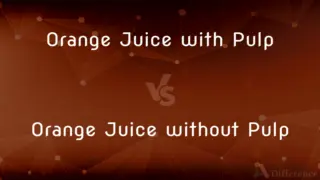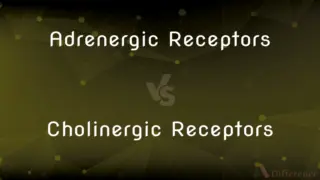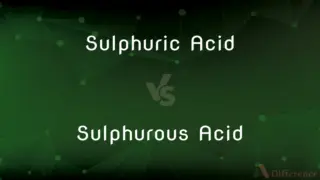Durum vs. Doner — What's the Difference?
By Tayyaba Rehman & Fiza Rafique — Updated on August 8, 2024
Durum is a type of wheat used in pasta and bread, while Doner is a meat dish cooked on a vertical rotisserie.

Difference Between Durum and Doner
Table of Contents
ADVERTISEMENT
Key Differences
Durum wheat is known for its high protein content and hardness, making it ideal for pasta and semolina-based breads. On the other hand, Doner kebab originates from Turkey and involves marinated meat, typically lamb, beef, or chicken, slow-cooked on a vertical rotisserie.
Durum, with its hard texture and high gluten content, is specifically cultivated for the production of pasta, ensuring the pasta retains its shape and texture during cooking. In contrast, Doner kebab's preparation involves marinating the meat in a mixture of spices and herbs, which imparts a distinctive flavor profile unique to the region or chef's preference. Durum's role in cuisine is largely foundational, providing the base for numerous dishes, whereas Doner serves as a main course, highlighting the interplay of flavors and ingredients.
The cultivation and processing of durum wheat are critical in determining the quality of the end product, such as pasta's texture and color. Meanwhile, the technique used in cooking Doner, including the speed of the rotisserie and the specific blend of spices, affects the tenderness and flavor of the meat. Durum's importance extends beyond its culinary uses, playing a significant role in agricultural economies, especially in countries known for pasta production. Conversely, Doner kebab's popularity reflects cultural traditions and culinary innovations, making it a symbol of fast-food cuisine in many parts of the world.
In terms of nutritional content, durum wheat is a significant source of carbohydrates, protein, and fiber, contributing to dietary health. Doner kebab, while also providing protein, can vary greatly in its nutritional profile depending on the type of meat used and the additional ingredients included, such as sauces and vegetables. Durum's contribution to a balanced diet is thus more consistent, while the nutritional value of Doner kebab can be adapted to meet different dietary needs or preferences.
Durum and Doner both play essential roles in their respective culinary worlds, with durum providing a staple ingredient in many traditional and modern dishes, and Doner offering a flavorful and versatile option for meals across various cuisines. Their differences highlight the diversity of food traditions and the ways in which ingredients and dishes can reflect cultural values and preferences.
ADVERTISEMENT
Comparison Chart
Type
Wheat variety
Meat dish
Primary Use
Pasta and bread production
Cooked on a vertical rotisserie
Origin
Mediterranean and Middle Eastern regions
Turkey
Cooking Method
Ground into semolina or flour
Marinated and slow-cooked
Nutritional Content
High in protein, carbohydrates, fiber
Protein content varies; can include fats and sauces
Compare with Definitions
Durum
A type of hard wheat used for making pasta.
Durum semolina is preferred for its ability to create firm pasta.
Doner
Served sliced with a variety of accompaniments.
A typical doner plate comes with vegetables, sauces, and sometimes rice.
Durum
Cultivated primarily for its high gluten and protein content.
Durum wheat fields are common in Italy and North Africa.
Doner
A Turkish meat dish cooked on a vertical rotisserie.
Doner kebab is often served in pita bread with salad.
Durum
Ground into semolina or flour for various culinary uses.
Durum flour is often used in bread making for its rich texture.
Doner
Popular street food and fast-food item worldwide.
Doner kebab stands can be found in cities across Europe and Asia.
Durum
Characterized by its yellow color and high hardness.
Durum grains are noticeably harder and more yellow than other wheat varieties.
Doner
Traditionally made with lamb, beef, or chicken.
Lamb doner is marinated overnight to enhance its flavor.
Durum
Essential in Mediterranean and Middle Eastern cuisine.
Durum wheat is a staple ingredient in many traditional dishes in these regions.
Doner
Known for its distinctive seasoning and cooking method.
The spices used in doner give it a unique taste that differs by region.
Durum
Durum wheat (), also called pasta wheat or macaroni wheat (Triticum durum or Triticum turgidum subsp. durum), is a tetraploid species of wheat.
Doner
Doner kebab
Durum
A type of wheat (Triticum turgidum subsp. durum syn. T. durum) having hard grains with high protein and gluten content, thought to have been developed in the Middle East in the Neolithic period and now used chiefly in making pasta.
Doner
Goner; someone who is done for.
Durum
Ellipsis of durum wheat
Durum pasta
Durum bread
Durum
Wheat with hard dark-colored kernels high in gluten and used for bread and pasta; grown especially in southern Russia, North Africa, and northern central North America
Common Curiosities
What makes Doner kebab unique?
Doner kebab's uniqueness comes from its method of cooking on a vertical rotisserie and its distinctive blend of spices.
What is durum used for?
Durum wheat is primarily used for making pasta and semolina-based breads due to its high gluten and protein content.
Can the spices in Doner kebab vary?
Yes, the spices used in Doner kebab can vary widely, giving it a distinctive flavor that differs by region or chef's preference.
Are there vegetarian options for Doner kebab?
Some places offer vegetarian Doner options using alternatives like tofu or seitan, seasoned in a similar way to traditional Doner.
Can durum wheat be used for anything besides pasta?
Yes, durum wheat can also be ground into semolina or flour for bread, couscous, and other culinary uses.
How does durum contribute to a balanced diet?
Durum wheat is a significant source of carbohydrates, protein, and fiber, contributing to dietary health.
Is Doner considered a healthy food?
Doner can vary in its healthiness based on the meat used, cooking method, and additional ingredients like sauces and vegetables.
What are common accompaniments with Doner kebab?
Doner kebab is often served with bread, rice, vegetables, and various sauces to complement its flavor.
How does the cooking method of Doner affect its flavor?
The slow cooking on a vertical rotisserie ensures that Doner kebab is tender and evenly seasoned, enhancing its flavor.
Why is durum preferred for pasta production?
Durum's high protein and gluten content help maintain pasta's shape and texture during cooking, making it ideal for pasta production.
Is Doner kebab eaten only in Turkey?
While originating from Turkey, Doner kebab is now a popular street food and fast-food item worldwide.
How is durum processed for culinary use?
Durum wheat is typically ground into semolina or flour, which is then used in making pasta, bread, and other dishes.
Can Doner be made with any type of meat?
Traditionally, Doner is made with lamb, beef, or chicken, but variations exist based on regional preferences and dietary restrictions.
Does the type of wheat affect pasta quality?
Yes, the type of wheat, especially durum, significantly affects pasta's quality, texture, and color.
What distinguishes durum from other wheat varieties?
Durum wheat is distinguished by its hardness, high protein and gluten content, and its yellow color.
Share Your Discovery

Previous Comparison
Cook vs. Cooking
Next Comparison
Broadway vs. OperaAuthor Spotlight
Written by
Tayyaba RehmanTayyaba Rehman is a distinguished writer, currently serving as a primary contributor to askdifference.com. As a researcher in semantics and etymology, Tayyaba's passion for the complexity of languages and their distinctions has found a perfect home on the platform. Tayyaba delves into the intricacies of language, distinguishing between commonly confused words and phrases, thereby providing clarity for readers worldwide.
Co-written by
Fiza RafiqueFiza Rafique is a skilled content writer at AskDifference.com, where she meticulously refines and enhances written pieces. Drawing from her vast editorial expertise, Fiza ensures clarity, accuracy, and precision in every article. Passionate about language, she continually seeks to elevate the quality of content for readers worldwide.















































